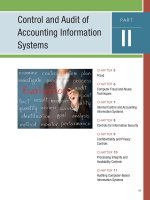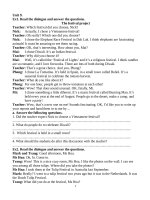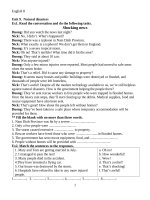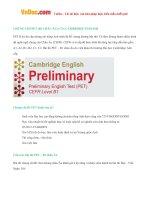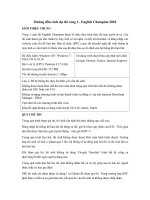Implications for teaching english modal auxiliary verbs
Bạn đang xem bản rút gọn của tài liệu. Xem và tải ngay bản đầy đủ của tài liệu tại đây (81.84 KB, 11 trang )
Implications for teaching English modal auxiliary verbs
1. Introduction
English is considered to be an international language used in many fields. It has
been taught in Vietnam for decades but it is several years since the learning and teaching
of English have been paid much attention to. It is, nowadays, widely recognized as the
key language tool in the integrating process into the world, English becomes the most
popular means of communication. Being aware of the importance of English, Vietnamese
learners try to master it. A lot of them are learning English as their working language with
foreigners, moreover, this language has become a compulsory subject in schools, colleges
and universities in Vietnam. However, to learn English well, Vietnamese learners have to
face a lot of difficulties, as English belongs to a quite different language family. One of
the most frequent difficulties is the use of verbs, especially modal auxiliary verbs in
particular. It is clear that, in English, verbs are the most complicated type of words used
most often, playing the first important position in comparison with other word classes and
in the verb phrase, modality is extensively used. When learning modal auxiliary verbs, a
lot of students often confuse "will" with "shall" or "must" with "have to". Their meanings
in Vietnamese may be the same but their uses in English are quite different. They cannot
distinguish between "I have to learn English every day" with "I must learn English every
day". In fact, the "have to" statement may be paraphrased "it is necessary for me to learn
English everyday" while the "must" statement may be paraphrased "in the present
circumstances I see it as necessary that learn English everyday". In this teaching
situation, the teacher has to look for the best way to make learners understand it better.
With the problems having been identified, I attempt to put forth some implications for
teaching modal auxiliary verbs.
2. Development
2.1. The importance of teaching modal auxiliary verbs
2.1.1. Supporting teaching verb phrase
1
When teaching modal auxiliary verbs in the presentation stage, the teacher
explains the meanings, the uses, the forms and presents structures, through
contextualization, dialogue and examples which need to be taught in the lesson. In this
way, modal auxiliary verbs are introduced to students. The explanation of grammar
structure and the presentation of modal auxiliary verbs are techniques that the teacher
uses to explicit the meaning and use of those modal auxiliary verbs to students.
Moreover, the aim of modal auxiliary verbs practice stage is to get students to learn the
structures so thoroughly that they will be able to produce them correctly on their own. In
this stage, some techniques like controlled practice, guided practice and free practice are
often implemented by the teacher. Consequently, the knowledge of modal auxiliary verbs
can be acquired by students.
2.1.2. Relating to other grammar points
According to Azar, S.B (1989, p.68), English modal auxiliary verbs are: can,
could, may, might, shall, should, will, would, must, need, ought to, dare, have to. They
are used with very great frequency and in a wide range of meanings. They generally
express concepts or attitudes relating to recommendation, obligation, necessity, and
prohibition; permission and refusal; possibility, expectation, probability and certainty;
promise and intention; ability and willingness. For example, they can convey the idea that
a speaker feels something is necessary, advisable, permissible, possible, or probable; and
in addition, they can also convey the strength of these attitudes. One of the features which
is very important and often causes difficulty in the study of modality is that many modal
verbs have more than one meaning or use, and in some cases two different modal verbs
have some meanings or uses in common, but are not completely interchangeable. When
teaching modal auxiliary verbs, teachers introduce modal auxiliary verbs to students
relating to grammatical structures of verb phrases. For example, students are taught to
combine modal auxiliary verbs with different tenses and their uses in various situations.
Students are introduced the grammatical structures which do not exist in Vietnamese
grammar such as "can/ must/ should have done something" and "will/ shall have done
2
something". They are also given the structures of three types of conditional sentences
with "would", hypothetical meaning and the conditions, which cause a lot of confusion
to students of English. Similarly, when teaching modal auxiliary verbs, teachers should
bear in mind the fact that modal auxiliary verbs are limited in their range of time
reference. That is why they always have to give students some related verb phrase
structures which express ideas such as possibility, ability, compulsion. probability and
willingness, etc. at different times: past, present or future or with different aspects:
perfective or continuous. In that way, other English grammar points are conveyed to
students of English through modal auxiliary verb teaching, and of course students will
have an overall view of grammar in that area.
2.2. Steps and techniques used to teach modal auxiliary verbs
There is no single method to teach modal auxiliary verbs, therefore, teachers
should base themselves on the content of the lesson, students' level, grammatical items
they want to teach in order to find a suitable method which they can achieve the best
results. On the whole, modal auxiliary verb teaching are carried out in two stages:
presentation and practice
2.2.1. Techniques for presentation
According to Mackey (1978, p. 302), presentation means communicating
something to somebody. It is an essential part of the method, the most carefully graded
selection of a language is useless unless it gets into the minds of the learners.
2.2.1.1.
Presenting the modal auxiliary structures through contextualization
"Modal auxiliaries are very problematic for most students as well because, unlike
other verbs in English, modals act like sentential operations. That is, they impart a quality
of probability, obligation, etc. to the entire sentence. Therefore, to communicate the
function and meaning of a modal, lessons must be richly contextualized with a variety of
examples" (Sharon Hilles, Techniques and Resources in Teaching Grammar, pp 54, 55).
3
Basing themselves on that idea, by means of contextualization in the teaching modal
auxiliary verbs, teachers should use either real or simulated situation to make learning
activity more effective and to increase the students' motivation.
-
Real situation: Teacher should make full use of real situation in the classroom and
combine them with the appropriate facial expression and actions to make the lesson more
interesting and the meaning of the items clearer. For example, teacher asks one student
some questions about his own experience:
T: Hung, I can type well. What can you do?
S: I can write carefully
T: Hung can write carefully. What can you do, Hoa?
S: I can play the guitar.
-
Simulated situation: This technique will be used when students do not understand
the structure so the situations are created by the teacher must be clear and easy to
understand.
For example, to teach "must", teacher may tell the following story about someone
in which "must" is used
"Yesterday, I went to see Mr. John. he was at home but he was not fine. He had
been ill for two days. His wife said that he could not go to work because of his bad health
and she was worried about his health very much. Therefore, I suggested that he should go
to see the doctor as soon as possible. He said that this Monday his wife would take him to
the doctor's/ Today is Monday. I call him but no one is at home. What can we conclude?"
Having introduced the text to students, teachers may call students to guess where
people in the story are. They may get answers such as " undoubtedly, John and his wife
must be in the doctor's"
4
Then teacher may write the sentence on board, and then tell them another story
which the inferential use of "must" can be elicited. When they have some sentences on
the board produced by students themselves, they can draw students attention to the
points. This technique is very necessary for teachers to teach difficult structures.
2.2.1.2.
Presenting the modal auxiliary structures through dialogues
Students often enjoy reading and doing role-plays as in dialogues so this technique
often achieves good results. Presenting modal auxiliary verbs and their equivalent
structures through dialogues, teachers do not have to waste time creating situations
because dialogues themselves are very clear in the situations. When learning dialogues,
students may meet some new structures. In this case, these structures should be
introduced and clearly presented. Teacher fives some explanation to make the meaning of
these structures clearly. And basing themselves on the context of the dialogue, students
can understand the structures used in the dialogue more clearly. After that, the teacher
helps students to practice these structures.
2.2.1.3.
Presenting modal auxiliary verbs and their equivalent structures through
visual aids
According to Adrian Doff, the simplest and clearest way to present a structure is
often to show it directly, using things the students can see: objects, classroom, yourself,
students themselves and pictures. For example, when using real objects, teacher can pint
to the blackboard and ask students "what can this blackboard be made of?" Or other
sentences such as " what could this desk be made of?" and "what can your shirt be made
from?" When using classroom, teacher can tell students about its cleanliness, and ask
them what classroom must be done every day, expecting answer like " the classroom
must be cleaned every day". In this way, modal auxiliary verb "must" can be practiced.
Teacher gives students some pictures with relevant contents and asks students to discuss
and give comments. In the class, visual aids can be used at any stage of the lesson
because good visual aids are not just used once, but again and again.
5
2.2.1.4.
Presenting modal auxiliary verbs and their equivalent structures through
examples
Teacher can use either inductive method or deductive method in teaching this
technique. It means that, the teacher could give a series of examples of the structures and
then students must draw out the rules themselves. The other way is that teacher explains
the rules with examples and students study the rules and finally make up sentences with
the help of teacher. In either way, students will have chances to use the language.
2.2.2. Teaching techniques at Practice stage
While purpose of the stage of presentation is to show the meaning and the use of
modal auxiliary verbs to students, the practice stage is aimed at developing students'
ability to use modal auxiliary verbs through different language practice activities. This
can be considered an important part in teaching modal auxiliary verbs because according
to Roger Gover and Steve Walters (Teaching Practice Handbook, 1983, p. 83), "language
that has been presented for the first time will normally need to be practiced orally by
students". In this stage, students have chance to practice sentence patterns, the structures
and can use them in suitable situations. There are three types of practice activities on
modal auxiliary verbs:
2.2.2.1.
Controlled practice
At this stage, teacher's work is shown in the following points:
-
Teacher helps students understand what they have to do with modal auxiliary
verbs and make sure that they understand them thoroughly
-
Teacher corrects students' mistakes
-
Teacher gives students prompts with new words on the board or visual aids to
practice language. In this practice, there are some techniques and exercises, which can be
used to teach modal auxiliary verbs.
6
* Repetition: Repetition is an indispensable activity in structural practice. Repetition can
be in chorus, in groups, in pairs or individuals. This kind of exercises is very easy to
design. After giving an example using the structure students have just learnt, the teacher
asks them to repeat it with correct stress and intonation. One point should be made clear
is that grammar is taught not only for sake of grammar but for sake of improving
students' language ability. In the light of that idea, besides teaching grammar, teacher
should also provide students with knowledge of phonetics and vocabulary in order to
develop four skills: listening, speaking, reading and writing. Teacher gives examples and
gets class to repeat them.
* Completion: students are given some parts of a sentence or a paragraph. They are asked
to complete the sentence or the paragraph. Completion exercise can also be gap filling
like close reading texts.
* Paraphrase: With given sentences, students are asked to rewrite them so that their
meaning remains unchanged, which is called sentence transformation.
* Situation practice: The objectives of teaching grammar in general and teaching modal
auxiliary verbs in particular is that students should know not only the form and meaning
of the structures but also their uses. That means students must know how to use the
structures in the right situations. Therefore, situation practice is very important. The
situations the teacher uses for practice must be from easy to difficult and must be closed
to real life situations.
* Meaningful transformation: In case students may not understand the new structure so
the teacher should use pictures as a kind of visual aids with meaning to get students guess
it and say it.
2.2.2.2. Free practice
The role of the teacher becomes less dominant in this stage. Teacher does not
spend time explaining things, students should be given more chance to try out the
7
language by themselves. In other words, teacher does not control the subject matter apart
from setting up the beginning of the activity, the students are free to say whatever they
want and choose the direction their conversation takes place.
Generally, practice of this kind should be followed by a free activity, which gives
students the chance to use modal auxiliary verbs and their equivalent structures to give
their own ideas or to talk about their own experience. There are two kinds of topics which
are useful for free oral practice:
-
We can get students to talk about real life
-
We can get students to imagine a situation that is natural
For example, when students have learnt structure " can do something" and passage
about Carol's ability " Carol Stuart is a good student. She is studying chemistry. She can
play the piano and the guitar very well.... She is beautiful, too", teacher can ask them to
talk about their abilities. S/he can begin by asking questions like the following:
-
Carol can play the piano and the guitar very well
-
Please tell me about your abilities
-
What can you do?
-
And who can play the guitar in the class?
Teacher lets students answer her questions by using modal auxiliary verb "can".
Furthermore, teacher requires students to work in pairs or in groups. Their task is to tell
each other or one another about their abilities.
For example:
A: I can paint my house. What can you do?
B: I can cook very well
8
At this step, with a large class, it may be necessary to make the activity more
highly organized, rather than done freely in groups. For example, teacher should ask
students in turn to give ideas, and get students to ask each other like "Carol can play the
piano. And you?" After a few minutes of working in pairs or in groups, students are told
to report their own abilities. At this time, teacher calls some representatives of some
groups to talk about their information they have got from practice work. And s/he can
correct students' mistakes if necessary. The aim of the activity is to get students to talk as
much as possible. So teacher should try to prompt rather than force students to talk.
Another common activity that can be used to practice the use of modal auxiliary
verb "can" is "find someone who can... (type/ swim/ speak English,...) With a pen and a
piece of paper, students are asked to move round classroom to ask their friends and note
down the information. after adequate time for practice, students are asked to report back
to the whole class on the information they have. Doing that way, students have the most
chances to practice all four skills in one activity. The less teacher says, the more chance
students have to speak. Consequently, students take an active part in the practice lesson
because they feel more confident and at ease when they can talk with their friends about
themselves in English.
3. Conclusion
Modal auxiliary verb is a small part of English grammar but it is always the heated
problem that needs to be discussed and it causes a lot of difficulties for learners of
English. English modal auxiliary verb plays a very important role in the grammar system.
It is a subclass, besides other subclasses: auxiliary verbs and lexical verbs. It has
functions both as an auxiliary verb and a lexical verb. Each modal verb carries many
different meanings, and each modal meaning can be expressed by many modal verbs but
of course, with different shades of meaning, which cause difficulties for the learners of
English especially for the beginners. Some techniques mentioned above can be used in
teaching modal auxiliary verbs, however, there is no single method or technique used to
9
teach a particular language point because of background of different learners, situations,
teaching and learning conditions. That is why teachers have to take those points into
consideration so that teacher can choose appropriate method, techniques in order to help
students learn better.
Due to short time and limited knowledge on this subject, mistakes and errors are
inevitable. All remarks and suggestions are well-received and deeply-appreciated.
Hopefully, this small study will be of great use to English learners, teachers, and to whom
care for this matter.
References
Gordon, E.M and Krylova, I. P., (1968) Modality in Modern English. Moscow.
10
Leech, Geoffrey and Svartwick, J. A., (1989) Communicative Grammar of English
Longman.
Azar, S. B., (1989) Understanding and Using English Grammar. United States of
America. Prentice Hall, Inc.
Doff, A., (1988) Teaching English - A framing course for teachers. Great Britain:
Cambridge University Press.
Sharon Hilles. Techniques and Resources in Teaching Grammar
Richards, J.C. and Rodgers, T.S., (1986) Approaches and Method in Language Teaching.
United State of America. Cambridge University Press.
11

